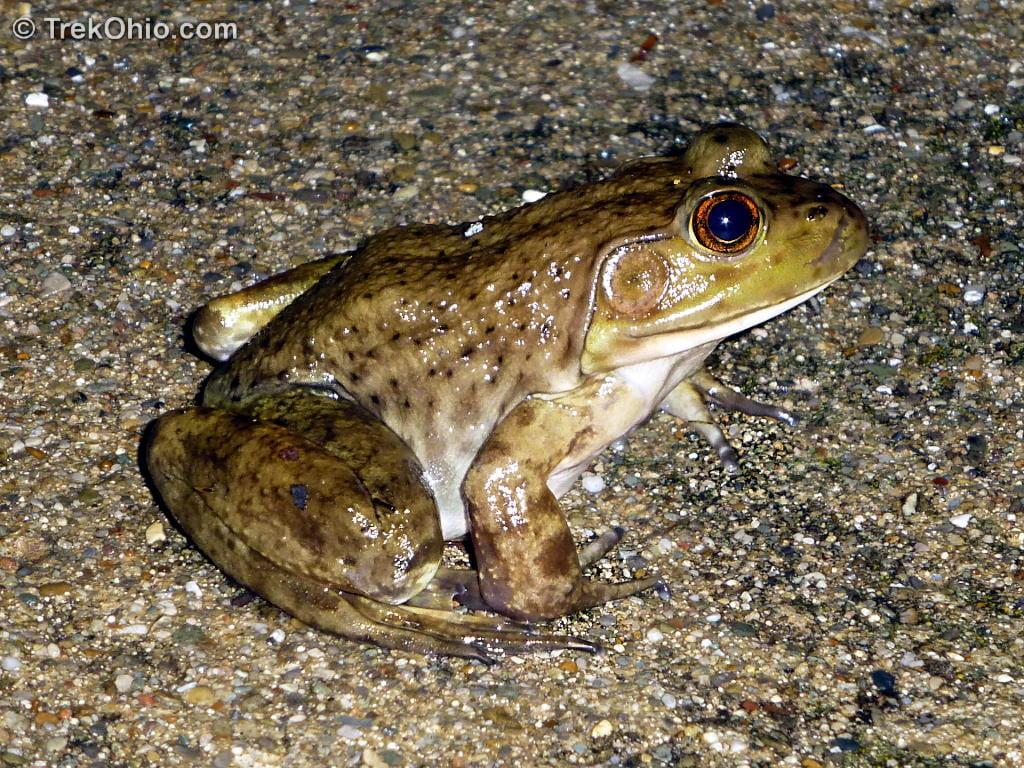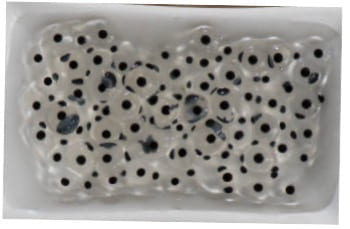Eco April’s: Freaky Frogs
By Tracy Winters, OSU Extension Education, 4-H Youth Development, Gallia County

TrekOhio, Eastern American Toad (Bufo americanus americanus) https://trekohio.com/2012/03/17/ohio-frogs-toads/
When we think about amphibians, frogs and toads are normally the first to come to mind. Here in Ohio the Northern Spring Peepers officially welcome the coming of spring in late February or early March with their mating calls. As we move into the warmer summer months of March through May the familiar long trill mating call of the Eastern American Toad fills the air.
FUN FACT: all toads are frogs, but not all frogs are toads
It is true, from a biological standpoint, all frogs and toads are in the scientific order Anura; it is within this order of frogs, that toads and frogs are separated out into families. Ohio is home to 15 species of frogs and toads in 4 families:
Frogs vs Toads
Ohio toads are:
- Thicker, bumpy, waterproof skin
- A parotoid gland that secretes toxins to their skin making them poisonous
- Normal size eyes for their size
- Stout, broad bodies, with shorter legs, suited for crawling and digging
- Crawl or make short hops to move about
- Lay eggs in long chains, sometimes attached to grass, or sticks in water
- Travel away from water, living in fields, wooded areas, lawns, and gardens
- Carnivorous as adults, catching their prey with a long sticky tongue and broad strong mouth
- Swallow food whole
- Absorb water through an area called a drinking patch
- Normally sit still and try to blend into their surroundings
- Lifespan varies, T]the common toad (Bufo bufo) lives up to 40 years, but most toad species live about 5 to 10 years.
Ohio toads are:
- Smooth, moist, slimy-looking skin
- Mostly stay near water, except some tree frogs
- Most are not poisonous; however, the Poisonous Dart frog (not in Ohio) is very poisonous
- When approached most frogs will leap to the safety of nearby water, except tree frogs who try to blend in with their environment
- Usually have big bulging eyes
- Are quick and hop long distances
- Long and lean bodies, with back legs that are normally longer than their body
- Lay eggs in large round clusters or masses that float near the water’s surface
- Are carnivorous and catch prey with long sticky tongues
- Some have teeth-like structures called maxillary or vomerine teeth in the roof of their mouth, that help hold prey but are not used for chewing
- Swallow food whole
- Absorb water through an area called the drinking patch
- Lifespans vary, Bullfrogs have been found to live up to nine years in the wild, and 16 years in captivity, but on average frogs live between four and fifteen years.
While reading about frogs can be fun, observing them is better! In this lesson plan, you will learn how to raise your own frog from egg to tadpole to frog! (Be sure to check your state’s fishing regulations on frogs before collecting eggs. Frog eggs can also be purchased from science education suppliers.)

Freepik, https://www.freepik.com/premium-vector/life-cycle-frog-frog-life-cycle-stages-set-with-adult-animal-fertilized-eggs-jelly-mass-tadpole_10844875.htm
Amphibian Habitat Projects
Did you know that amphibian species are disappearing at an alarming rate all over our planet? Scientists believe this decline is due to a combination of pollution, habitat loss, and climate change. What can we do to help?
- Protect existing habitat: educate others about the importance of protecting woodlands, wetlands, and keeping our watersheds healthy
- Avoid the use of pesticides and herbicides, amphibians are highly susceptible to them due to their absorbent skin
- Participate in scientific monitoring projects like “Frogwatch USA” and The Ohio Frog and Toad Calling Survey
- Create your own amphibian habitat

Rehabilitation wildlife projects, https://www.yorkshirepost.co.uk/country-and-farming/new-project-help-yorkshires-amphibian-population-and-restore-wildlife-habitats-given-major-cash-boost-3069491
Three backyard habitat improvement projects for amphibians
- Build a water feature in your backyard. You can choose between building a backyard pond, making a small backyard marsh area, or even creating a container pond using large shallow containers or watering tubs
- Create a toad abode! Your toad abode will provide shelter from the heat and predators
- Create a food source or area for foraging. Remember amphibians are carnivores and feed on worms, grubs, and other insects. Suitable foraging areas include compost piles, log piles, or any place that provide shade, and decomposing materials that attract invertebrates
To create a toad abode, turn a ceramic flowerpot upside down, add a toad-sized hole in the side for an entrance, or prop it up with a rock to allow the toad access. Abodes with dirt floors are best to allow toads to dig. Place your toad abode in a shady spot near a water source, such as a small pond or even a larger saucer of water.
Citizen science (also known as community science, crowd science, crowd-sourced science, civic science, or volunteer monitoring) is scientific research conducted, in whole or in part, by amateur scientists. Citizen science is sometimes described as “public participation in scientific research,” participatory monitoring, and participatory action research whose outcomes are often advancements in scientific research by improving the scientific community capacity, as well as increasing the public’s understanding of science.
Spring into STEM: Freaky Friday Frogs Lesson Plan
Frog Metamorphosis Observation Sheet
TAKE ACTION TODAY: Check out Frogwatch USA – this citizen science program provides opportunities to learn about and gather information on the health of wetlands in your community by reporting frog species present by identifying their calls.
Resources:
Ohio Amphibians.com, http://www.ohioamphibians.com/index.html
The Ohio Frog and Toad Calling Survey, http://www.ohioamphibians.com/frogs/callsurvey/index.html
Amphibians of Ohio field guide Division of Wildlife, https://cpb-us-w2.wpmucdn.com/u.osu.edu/dist/0/90535/files/2020/06/Amphibians.pdf
The Buzz Forest Preserve District of Will County, https://www.reconnectwithnature.org/news-events/the-buzz/what-s-the-difference-frog-vs-toad
Reptiles Guide Frogs vs. Toads, https://reptile.guide/frogs-vs-toads/
Habitat Management Guidelines for Amphibians and Reptiles of the Northeastern United States, http://northeastparc.org/wp-content/uploads/2015/08/Final-NE-HMG.pdf
TrekOhio, Hiking the Parks & Preserves of Ohio, https://trekohio.com/2012/03/17/ohio-frogs-toads/
Peer-reviewed by: Peer-reviewed by: By Travis West, Extension Educator, 4-H Youth Development, Vinton County; Jessica George, OSU Extension, 4-H Program Assistant, 4-H Youth Development, Erie County; Kelly Royalty, OSU Extension, 4-H Program Assistant, 4-H Youth Development, Clermont County; Demetria Woods, OSU Extension Educator, 4-H Youth Development, Miami County; and Meghan Thoreau, OSU Extension Educator, Community Development & STEM, Pickaway County.








